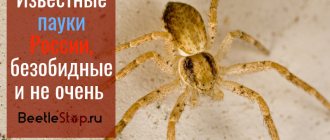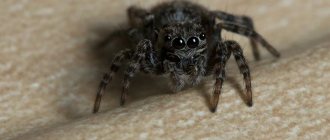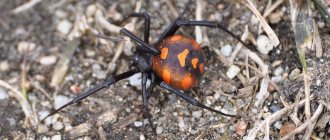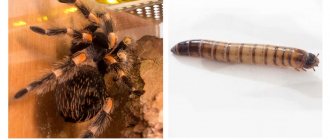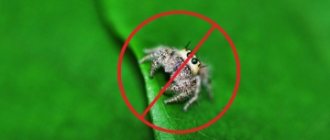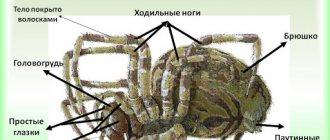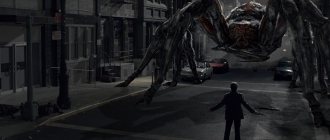What does a sand spider look like?
In order to accurately identify this type of spider when meeting it and, if possible, avoid the potential danger of a bite, it is necessary to be aware of what external parameters this arthropod has.
Did you know? Spiders of this species have a fairly high life expectancy compared to their other close relatives. For comparison, the average lifespan of a tarantula is about three years, while a sand spider can be active for up to 15 years.
The appearance of these spiders is quite memorable, and it is difficult to confuse them with any other representatives of the arachnid order.
The most striking external features of the sand spider are as follows:
- torso. Wears brown, light gray or dark yellow color. Quite oblong, slightly flattened laterally. It consists of the abdomen and cephalothorax, the bridge between which is practically not visualized. On the dorsal side of the cephalothorax there is a pattern resembling a violin turned with the neck towards the back of the body. The entire body is covered with hard, medium-length hairs;
- head. Starts directly from the edge of the cephalothorax, there is no neck. On the front part of the head there are jaws protruding forward for quite a considerable distance, on the sides of which large pedipalps protrude;
- eyes. A distinctive feature of this type of spider is that they have only six eyes (usually most spiders have eight), which are located in three pairs - one in the center, and one more slightly higher to the left and right of the central one. Eye color: black;
- limbs. In total, this type of spider has four pairs of legs. Very long, and all of approximately the same length, always widely spaced, colored mainly in the same tone as the body, covered with a small number of short hairs. Each leg consists of four segments, which gives it greater stability, speed and mobility compared to spiders, whose legs consist of three segments. The paw span of this insect varies from 5 to 25 mm;
- This species has weakly expressed sexual dimorphism: females are slightly larger than males, have less pronounced pedipalps and a longer abdomen. The main distinguishing feature of this type of spider from other six-eyed representatives is the complete absence of any patterns on the abdomen and limbs.
Did you know? The movement of the legs of this type of spider is ensured with the help of flexor muscles and hemolymph, which circulates through the lymphatic system of the insect and performs the function of extensor muscles.
This is why, when a spider receives a wound, it becomes very lethargic and moves poorly.
Chilean recluse spider
This arthropod is also one of the ten most dangerous on our planet. Its habitat is the western United States. You can meet the recluse spider in the states of Iowa, Nebraska, as well as Indiana and Texas. This is one of the largest arthropods of this species. The length of its body, including limbs, often reaches 1.5 inches. Translated from Spanish, the name of this representative of the animal world is “brown spider.”
Despite its small size, ranging from 6-20 millimeters, the bite of the Chilean hermit can cause painful death. Toxic substances contained in his saliva cause paralysis of all internal organs, as well as hemolytic anemia and severe renal failure.
Distribution and lifestyle
The natural habitat of this insect species is limited mainly to the hot, arid regions of the African continent and the New World. Individual representatives of six-eyed sand spiders with slightly different morphology can also be found on the Australian continent and the Galapagos Islands. There is also a separate subspecies called Loxosceles rufescens ,
which, being originally endemic to the Mediterranean, has spread almost throughout the world and is now found sporadically on all continents.
The ideal habitat for the six-eyed sand spider is, as the name suggests, any area of land covered with sand. It can often be found in deserts, fields with sandy soils and sandy loams, and on areas of sandy beaches remote from the water surface. Some representatives have managed to adapt to life in denser soil, for example, Loxosceles laeta, which can be found in the vastness of Finland, takes root well in clay soils and black soil.
Important! If you come across a spider somewhere in the wild that is similar in appearance to a representative of this species, it is better to stay away from it. Take into account the fact that certain subspecies of six-eyed sand spiders have spread throughout the world, and their venom is dangerous to human health.
These insects feel quite at ease near human dwellings. Very often, their web nests can be found in armfuls of firewood, wooden boards, in boxes, heaps of old clothes, behind baseboards and inside the hollow walls of houses. The suitability and comfort of the living conditions created by man for himself, also for spiders, is explained primarily by the fact that in the construction of modern houses a fairly large amount of stone and wood is used, in the crevices of which six-eyed sandstones are often built.
During the daytime, representatives of this species of spiders prefer to spend time in the territory adjacent to the location of their nests, or in various shelters. Often driftwood and stones play this role for them. If the spider is unable to find shelter for the day, it buries itself deep in the sand so that the scorching sun all day does not cause significant harm to it.
Find out what the peacock spider, tarantula spider, Apulian tarantula, Goliath spider, Brazilian wandering spider and black widow look like and where they live.
When night falls, these insects go hunting. Their main food is other insects, as well as smaller representatives of their own subspecies. These spiders have the ability to weave webs, which they use quite actively. Their webs are not intended for catching prey, but only serve to preserve animals that have already been caught and not eaten, and are also the main location for spiders during rest.
In addition, the web plays a fairly important role in the reproduction process. Males can often move quite far from their webs and not appear near them for several days, while females prefer to stay close to their web and return to it every day to rest.
Brazilian spider
This representative of arthropods is the most dangerous on our planet. For this reason, it was even included in the Guinness Book of Records. With him we begin the top 10 most dangerous spiders in the world.
Where does he live? The Brazilian wandering spider can be seen in the American tropics or subtropics. At the same time, two groups of these representatives of the animal world are distinguished. The first of these includes jumping spiders. They are called so by the way they pursue the victim. These spiders catch up with their prey using jerky jumps.
The second group includes running arthropods. These Brazilian spiders are very fast in pursuit of their prey. Representatives of the second group go hunting at night. During the daytime they hide under stones or in places where they cannot be seen. Such spiders can live both on the ground and in trees.
Why are these arthropods called wandering? The fact is that the Brazilian spider does not weave a web like its relatives. He constantly changes his place of residence, moving in search of food.
The most dangerous spider on our planet causes a lot of trouble for residents of South America. This poisonous creature gets into their homes. The Brazilian wanderer is often found in boxes of food or in closets with clothes.
What features does the most dangerous spider on our planet have? It is distinguished by its small size. The Brazilian wanderer can grow up to 10 cm in length. However, their small dimensions do not prevent these arthropods from being the most dangerous spiders in the world (see photo below).
They are excellent hunters and pose a great danger to humans. It is worth saying that the bite of this arthropod leads to suffocation, often resulting in death. The good news is that to save human life there is an antidote that should only be administered in time.
Of course, healthy adults do not have to worry about their lives after being bitten by the most dangerous spider on our planet. They can only have a strong allergic reaction to its poison. But toxins that enter the body of a child or a sick person can lead to the most tragic results.
What does the most dangerous spider on our planet prefer to eat? His favorite treat is bananas. That is why Brazilian wanderers prefer to climb into the boxes in which these fragrant fruits are stored. For such love, this representative of arthropods is often called the “banana spider.” However, the main food for him, of course, is not fruit at all. The most dangerous spiders in the world (see photo below) hunt insects.
Even relatives of other species become their victims. In addition, Brazilian wanderers attack birds and lizards, which are significantly larger than them.
The most dangerous spiders in the world do not attack people. They bite humans only for the purpose of their own protection.
How to hunt and what to eat
As already mentioned, the main food for these insects are other, smaller insects and invertebrates. Most of the hunting cycle of representatives of this species takes place at night in a quiet, long wait for the appearance of a potential prey. Having buried itself in the sand in order to hide from a potential enemy and future food, the six-eyed sand spider can, thanks to its powerful and strong paws, jump out of its hiding place at any moment and attack with its jaws.
When he bites, he injects the poison contained in his saliva into the victim’s circulatory system, which has a pronounced neurotoxic, hemolytic and paralytic effect. After the insect is paralyzed, the spider decides whether it needs food at the moment or whether it can drag the prey to its nest and leave it there in reserve. In this case, the male does not bear any responsibility either for the female he fertilized or for possible offspring.
Important! After eating a hearty meal, spiders of this subspecies can fall into a state of stasis, from which they do not emerge for a whole year, if they manage to find comfortable living conditions for themselves. Therefore, if you find an immobilized and, at first glance, even dead spider, do not try to touch it with your hands or disturb it in any other way.
He strives to feed only himself, but the female is forced to look for food both for herself and for the little spiderlings. Sometimes these spiders freeze on the surface of stones during a hunt if they match their color and wait for the prey in this position.
This is more typical in areas where the main food of sand spiders are scorpions and other fairly large invertebrates that prefer to move along ridges of stones rather than along sand. As for the representatives living in clayey soils and chernozems, they prefer to hunt, taking an initial observation position directly at the entrance to the crevice or hole leading to their nest.
Yellow Spider Sac (Cheiracanthium)
The spider, barely 10 mm in size, causes extensive tissue necrosis at the bite site with its venom. It is not fatal, but extremely painful. The golden spider lives in European countries, Australia and Canada. Some experts believe that spiders of this species are responsible for more bites than any other spider.
Reproduction and development of offspring
Females and males form pairs exclusively for the mating period, which is not limited to any time intervals and can vary for each individual individual. The mating process is initiated by the female, beginning to secrete specific pheromones that have attractant properties towards males. Since these spiders do not live in large concentrations, often more than one male rarely appears when a female calls, and accordingly, conflicts for the right to own a female almost never happen between males.
10–15 days after the fertilization process occurs, the female is ready to lay a clutch containing eggs. For these purposes, she weaves a cocoon from her own web with the addition of sand, into which she lays eggs. After this, she works for some time to provide food for her future children for the first time, attracting killed insects and invertebrates to the cocoon.
Important! The chitinous shells shed by spiders have a fairly hard structure and are often used by arachnologists to identify the exact species of the spider and for various scientific research.
But the young spiders will have to hatch without a female - their maternal instinct is not so strongly expressed as to continue to provide the young offspring with food to their detriment for too long a time. At first, a colony of newly hatched young spiders sticks together, not moving far from the area where the mother left food for them.
This mode of life can last up to one month, and then the already strong spiders begin to gradually disperse in different directions in order to move away from potential competitors in search of food and in order to avoid clashes over territory. The six-eyed sand spider is considered fully mature after shedding its chitinous shell six to eight times.
Black widow (Latrodectus)
One of the most “famous” species of spiders on the planet. Before the invention of an antidote, most attacks by black widows on humans were fatal. Latrotoxin released by the spider causes blood poisoning. The victim suffers from bouts of vomiting and spasms in all muscles. Lives in North America and Australia.
